Easy No-Knead Bread
This easy No-Knead Bread loaf has a deliciously crisp crust and a soft spongy center. It’s the perfect blend of soft and chewy. With only 4 ingredients (flour, salt, yeast and water), you can make a bakery-quality, scrumptious loaf of homemade bread.
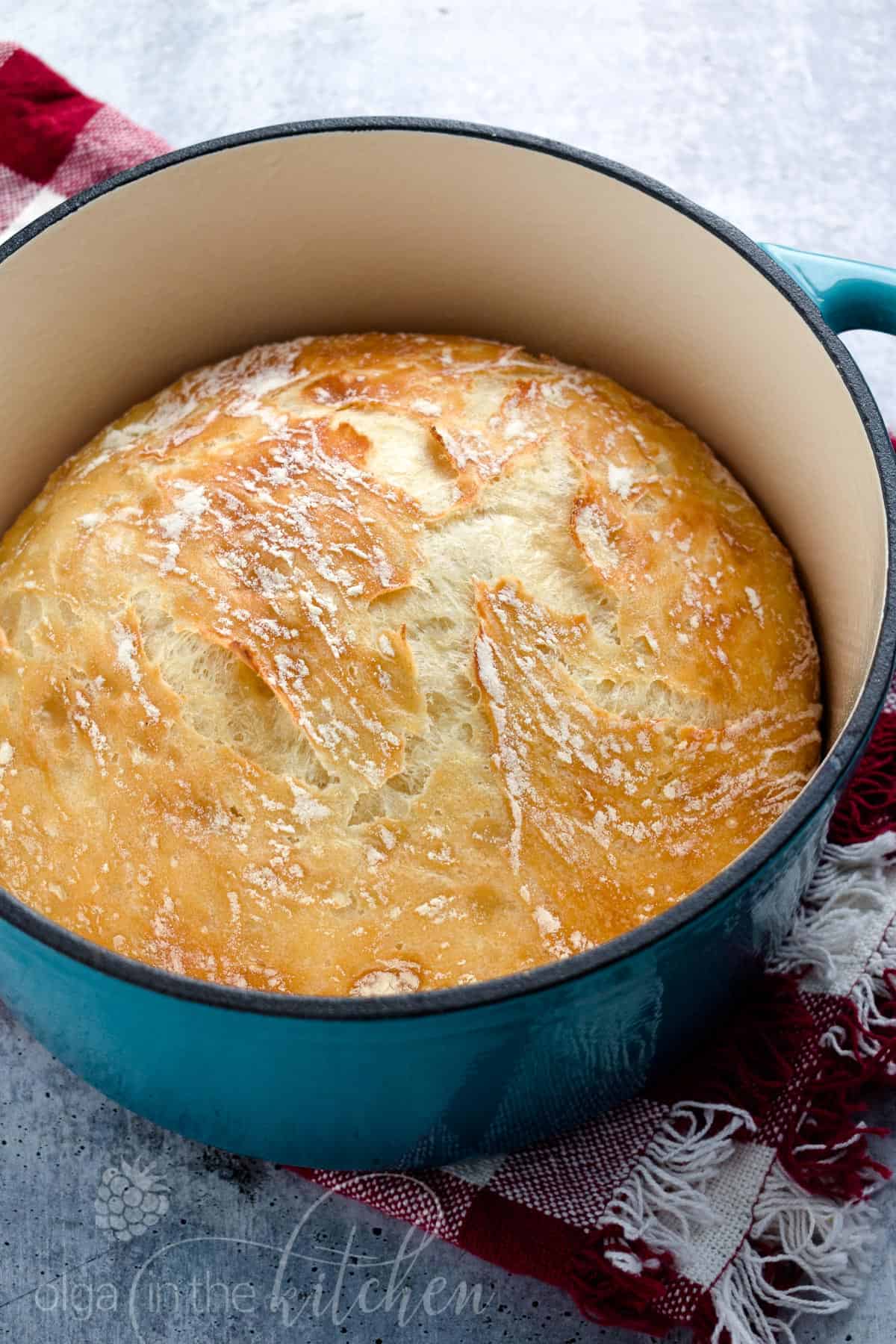
This post may contain affiliate links. Read my disclosure policy.
Easy No-Knead Bread Recipe:
Dutch Oven Bread is surprisingly easy – there is no kneading required. You just need a bowl and a wooden spoon to stir the ingredients together. Let it rise on the counter overnight and it’s ready for the oven.
We love the aroma of freshly baked homemade bread in our house, like from our staple White Bread Machine Bread, our classic French Buns and of course for the sweet tooth: Cheese Sweet Rolls.
We make bread in our kitchen at least twice a week. According to my husband, this easy no-knead bread is the best for him. We made this recipe countless times because it’s so easy and needs so little attention. It bakes to perfection every time and you will fall in love with the spongy soft texture instantly.
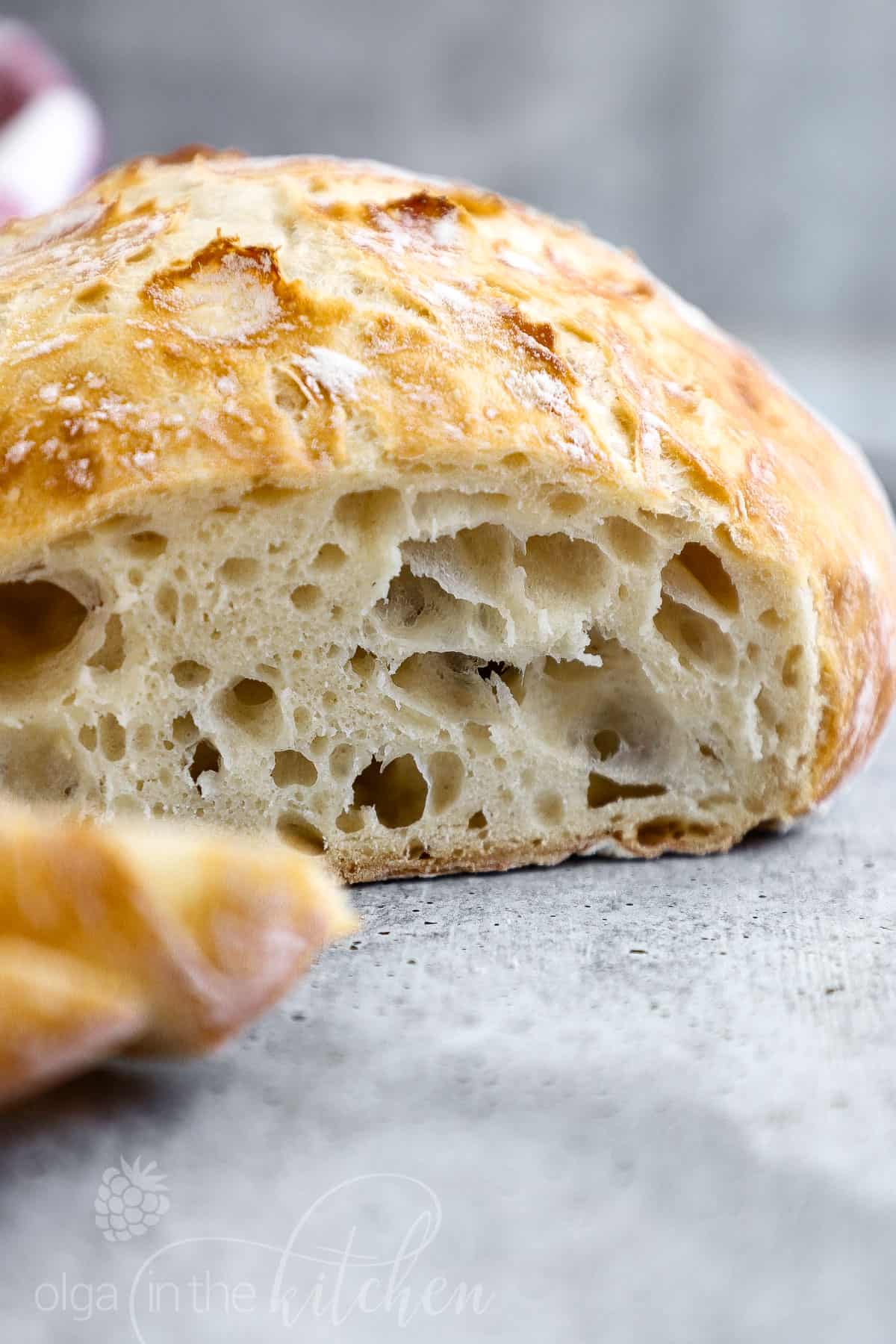
What is the Best Flour for Bread?
Bread flour is typically recommended for bread making, but this recipe works great with either bread flour or all-purpose flour. We have tested both and we don’t see difference between the two. Both rise nicely and provide incredible results. I prefer using all-purpose flour because it’s the one I always have on hand for all the baking I do.
Ingredients for Easy Dutch Oven Bread:
The ingredient list is short and the measurements can be found on the printable recipe card at the bottom of this page.
- Flour – we need all-purpose flour that you all have in your pantries. No need for the fancy stuff!
- Fine salt – gives flavor and makes it extra delicious.
- Instant yeast – I use instant dry yeast as it’s my #1 yeast in the house, but you can definitely use active yeast. I tried with both, and don’t see difference.
- Warm water – it’s important to make sure your water is at room temperature, but not too hot so it doesn’t deactivate the yeast.
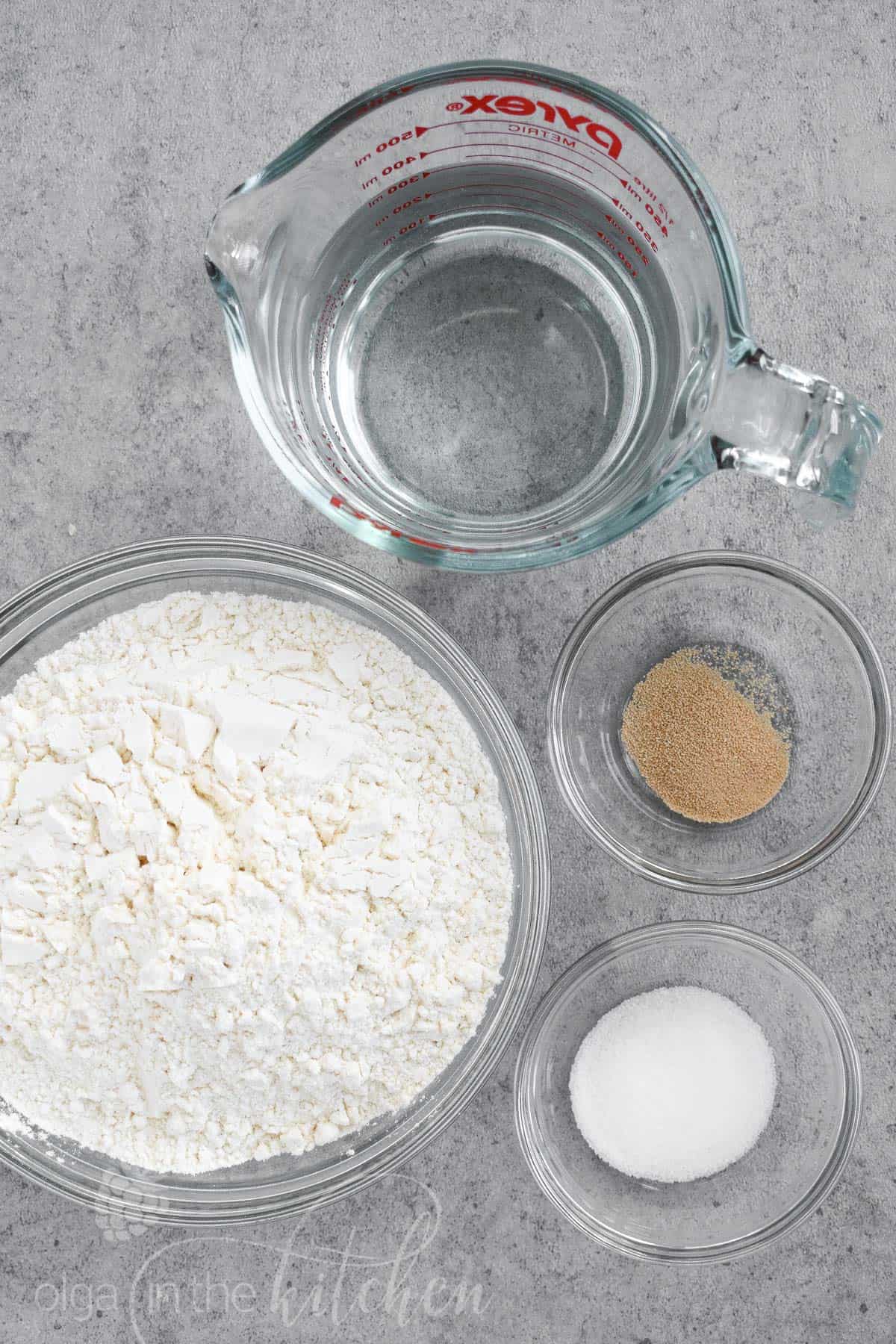
How to Make Easy Homemade Bread:
1. In a glass measuring cup, combine to dissolve warm water (100-110°F) and sprinkle instant dry yeast over the top. Let it sit 2-3 minutes.
2. Into a large mixing bowl, sift all-purpose flour and add salt. Whisk to combine.
3. Pour in the water mixture and use a wooden spoon to stir until all of the flour is incorporated (do not knead). The dough will be very sticky, but do not add additional flour.
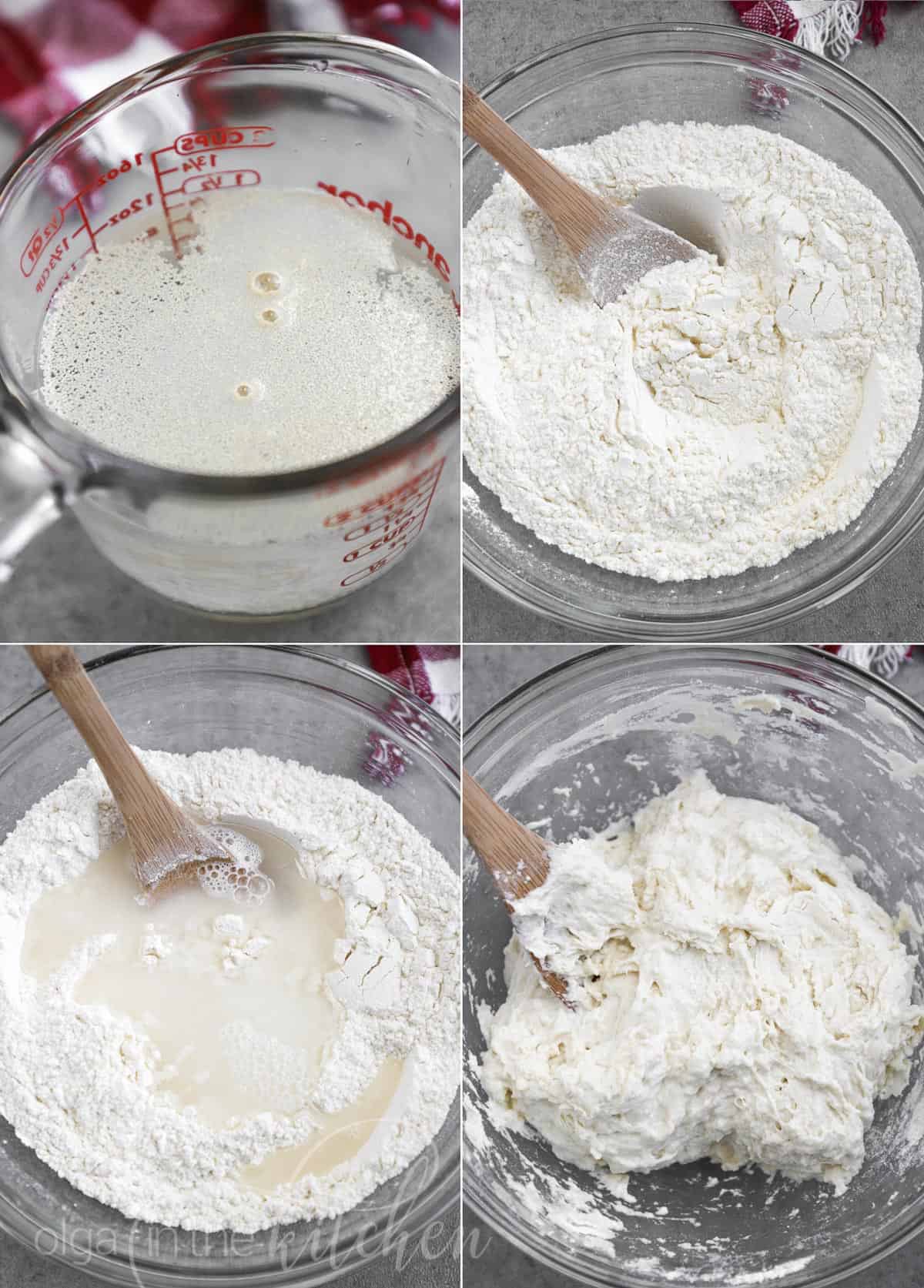
4. Cover the bowl with plastic wrap and let the dough rest on your counter or inside your unheated oven for 18 hours to 24 hours.
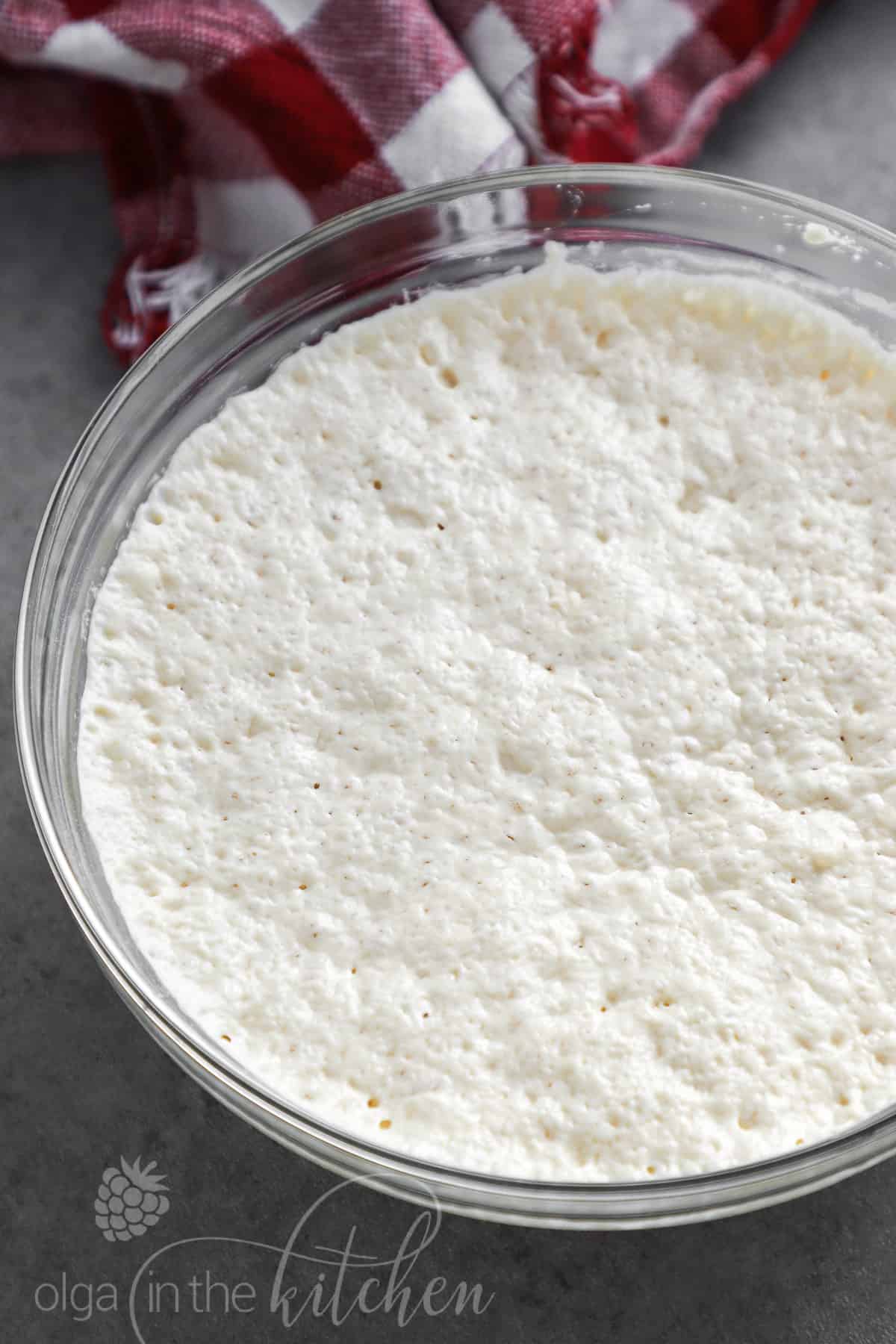
5. Place an empty dutch oven and lid inside the oven and preheat the oven to 450 degrees Fahrenheit. Once preheated, remove dutch oven and place on the stove. Be careful not to touch the dutch oven or lid without oven mitts because it will be very hot.
6. Meanwhile, generously dust a cutting board or work surface with flour. Using a rubber spatula, scrape the dough out (which will be very thin and sticky) onto the floured surface. With help of pastry scraper or well-floured hands, shape the dough by folding the dough in half and then fold in half again, pulling the dough together into a loose ball.
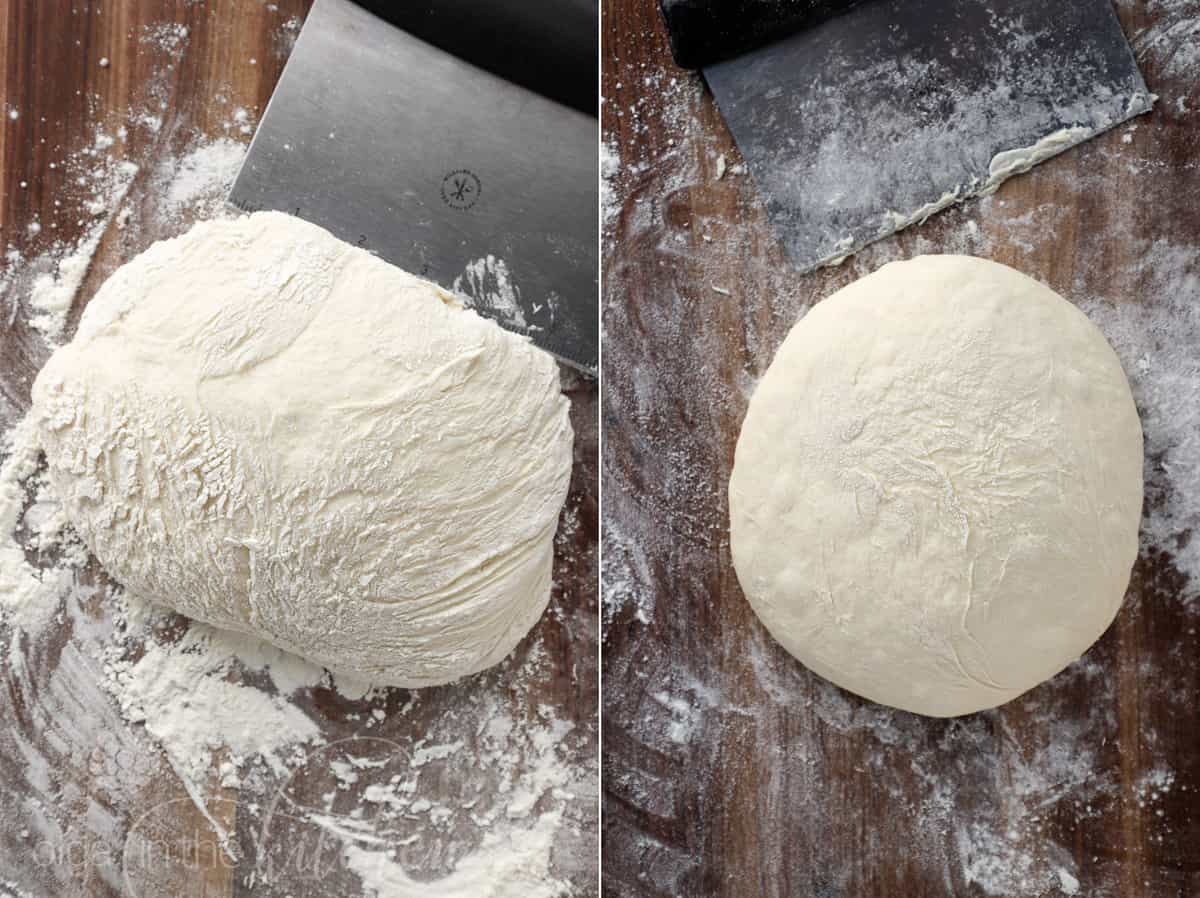
7. Sprinkle the bottom of the dutch oven with flour or cornmeal and carefully place (or drop) the dough in the center of your hot dutch oven. Cover with lid and bake for 30 minutes at 450°F. Carefully remove hot lid and bake for another 15 minutes to 20 minutes until golden brown.
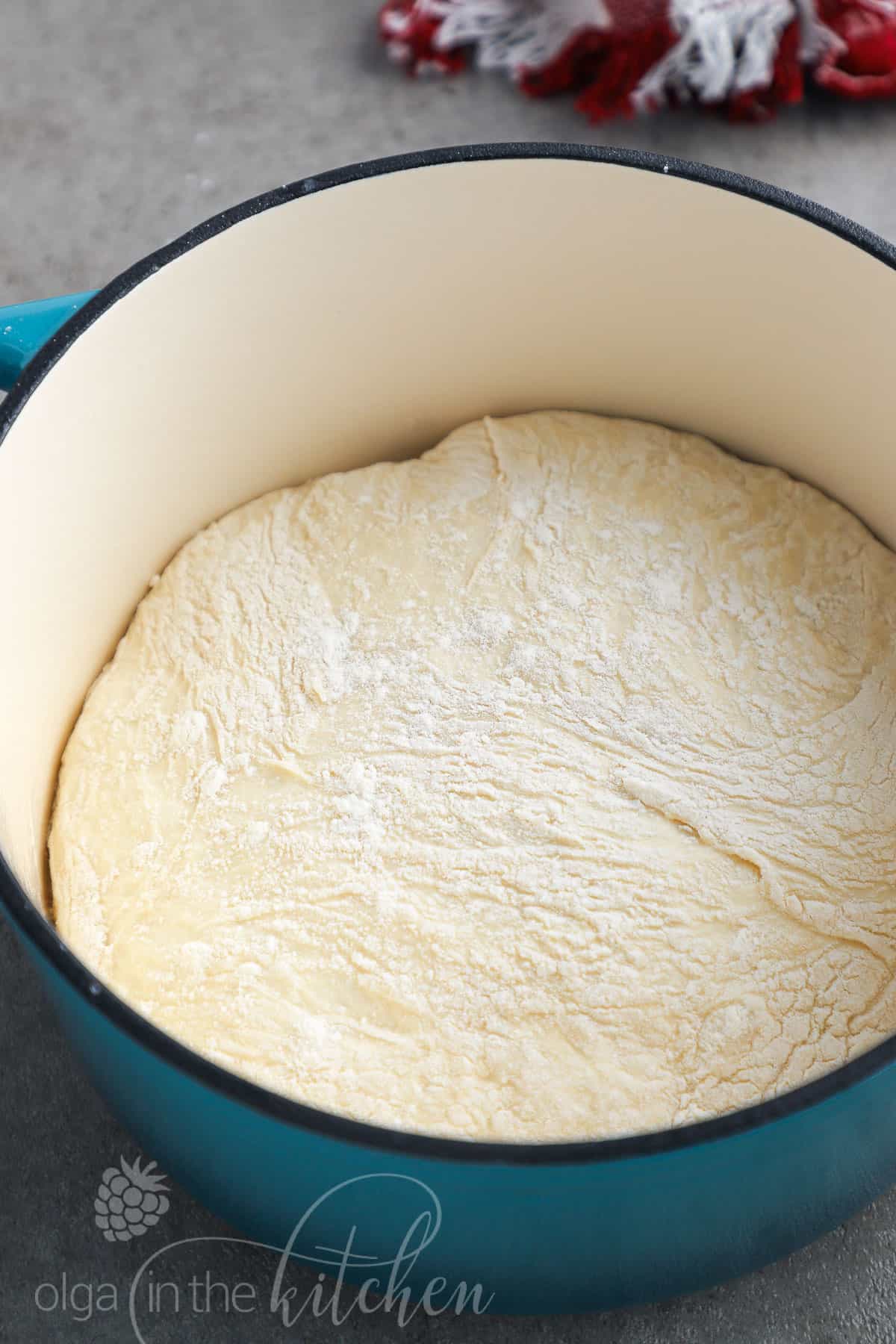
8. Remove the bread from the pot (it should fall out easily) and place directly on wire rack to cool completely until it’s nearly room temperature before slicing it.
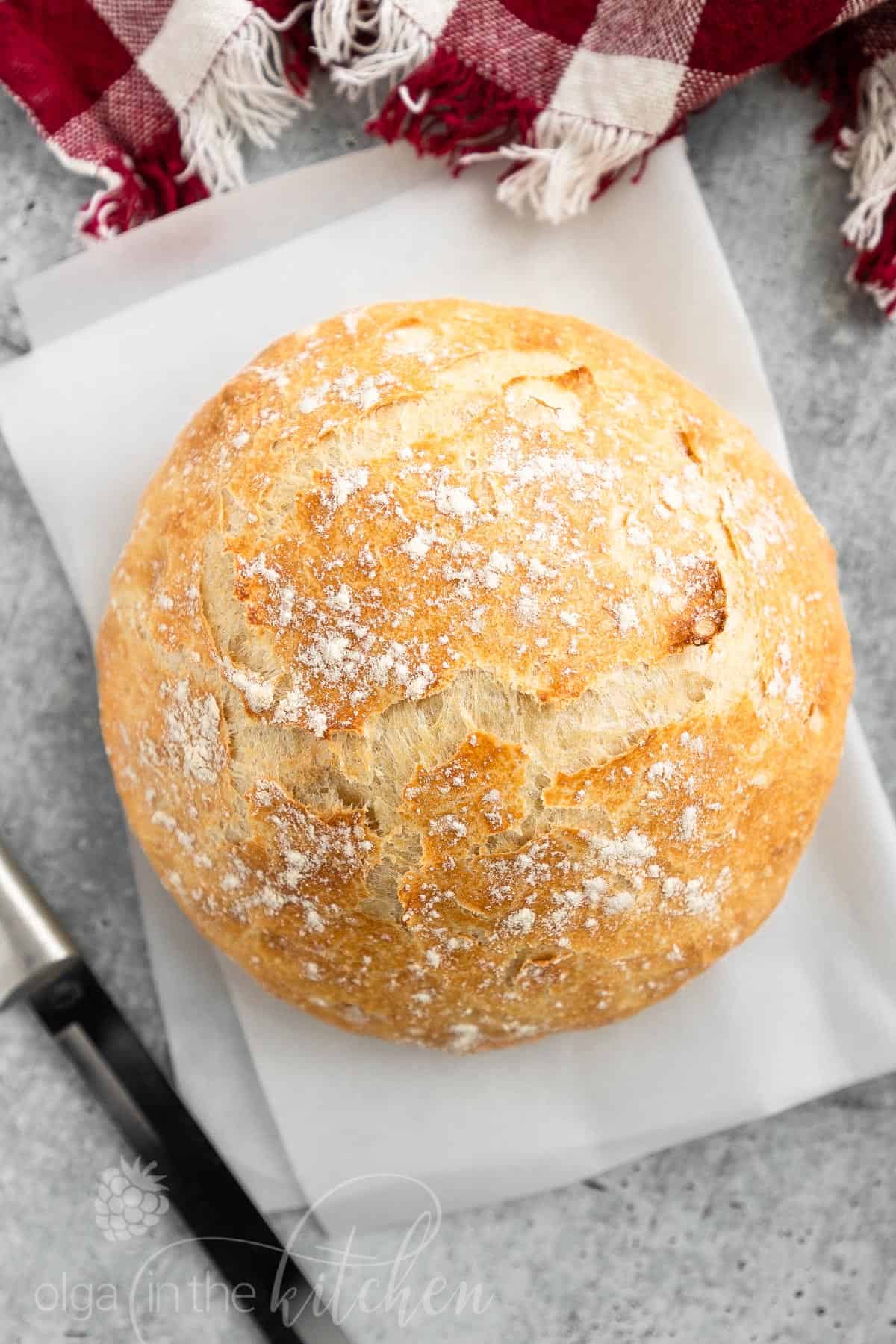
Quick Tips:
- Use warm water – between 100°F to 110°F. Avoid using hot water or it will deactivate the yeast.
- Substitute for active yeast – instant dry yeast can be replaced for active dry yeast. Use 3/4 teaspoon active dry yeast in this recipe.
- Measure correctly – spoon flour into a measuring cup and level off the top with the back of a knife.
- Rising the dough – draft-free room temperature, unheated oven or turned off microwave. Avoid placing dough into hot oven to rise. Hot temperature will deactivate and ruin the yeast.
- For round, less flat bread – use a 4qt or 5 qt dutch oven so that the bread rises upwards, rather than spreading out over the entire surface of bigger pot.
- Preheat the oven and dutch oven – placing the bread into hot dutch will help form a beautiful crust.
- Flour the dutch oven – to make sure your bread doesn’t stick to the pot, sprinkle flour or cornmeal on the bottom of the preheated pot.
- Cool before slicing – always wait for hot bread to cool to room temperature before slicing. Cutting it while hot, will release too much steam and the bread will become gummy.
Do You Need Dutch Oven?
The key to making this crusty easy no-knead bread is that you need something really heavy and thick so that it holds and radiates heat well and it must have a lid. A thick glass or stoneware dish may also work, but probably not as well as cast iron dutch oven.
I used a 4 qt Martha Stewart dutch oven, which can be purchased as low as $40 on sale. You do not need to spend hundreds of dollars on single dutch oven. Martha Stewart and other brands have different sizes of dutch ovens for a lot cheaper. They all do the same job!
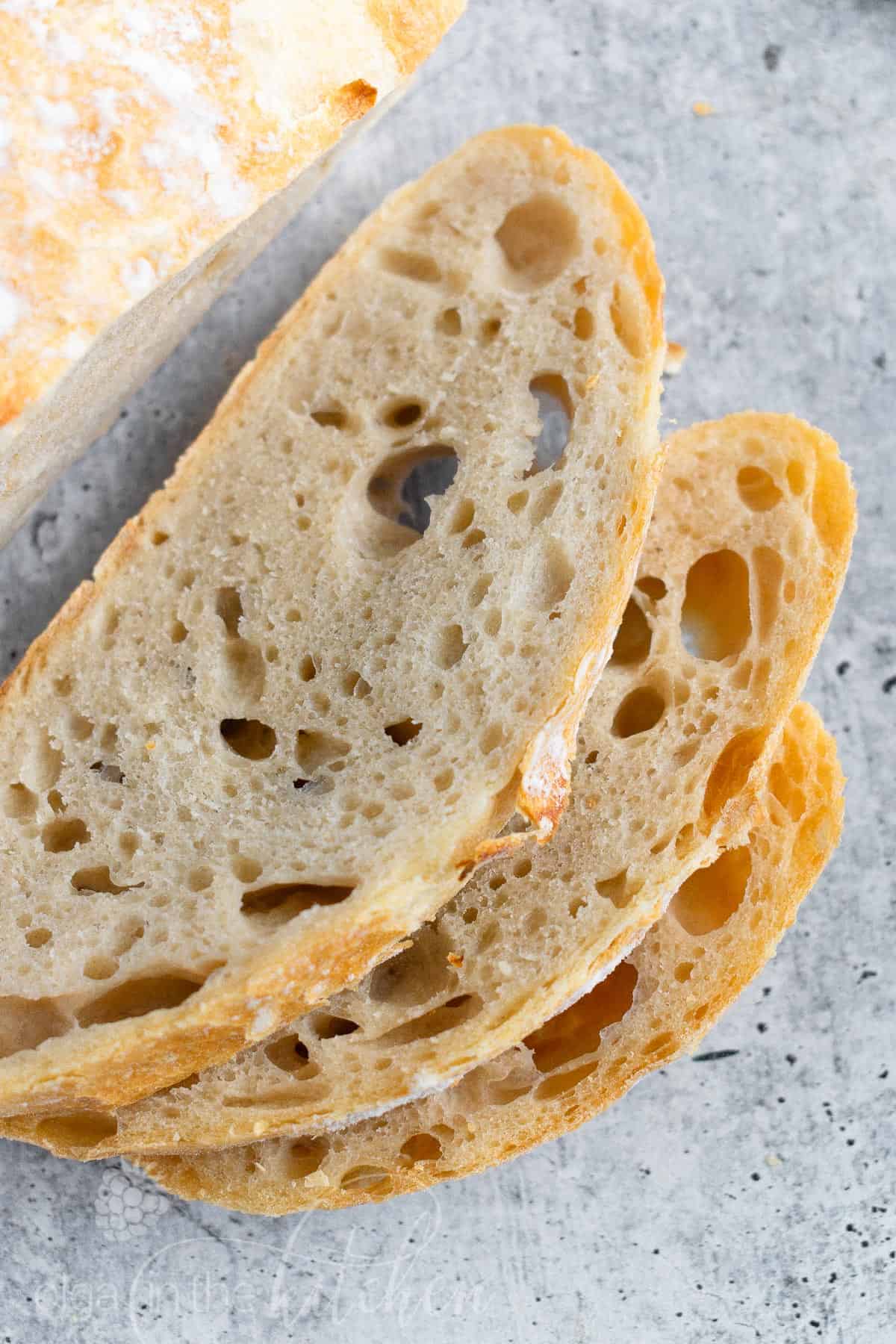
Do I Need to Proof the Yeast?
You do not need to proof the yeast for this bread recipe. You can just combine it with flour. However, I like to dissolve the yeast in water before combining with the flour to make sure it incorporates equally throughout the dough.
Why Did my Bread Stick to the Pot?
To prevent your bread from sticking to the pot, make sure your dutch oven is hot enough before adding the dough. Also, make sure to sprinkle some flour or cornmeal on the bottom of hot pot before adding the dough.
Alternatively, you would use parchment paper to keep bread from sticking to the pot, but I don’t do it because all the brands of parchment paper I have say 420°F maximum. I don’t want my oven or your oven to get on fire, so let’s use flour to avoid any risk.
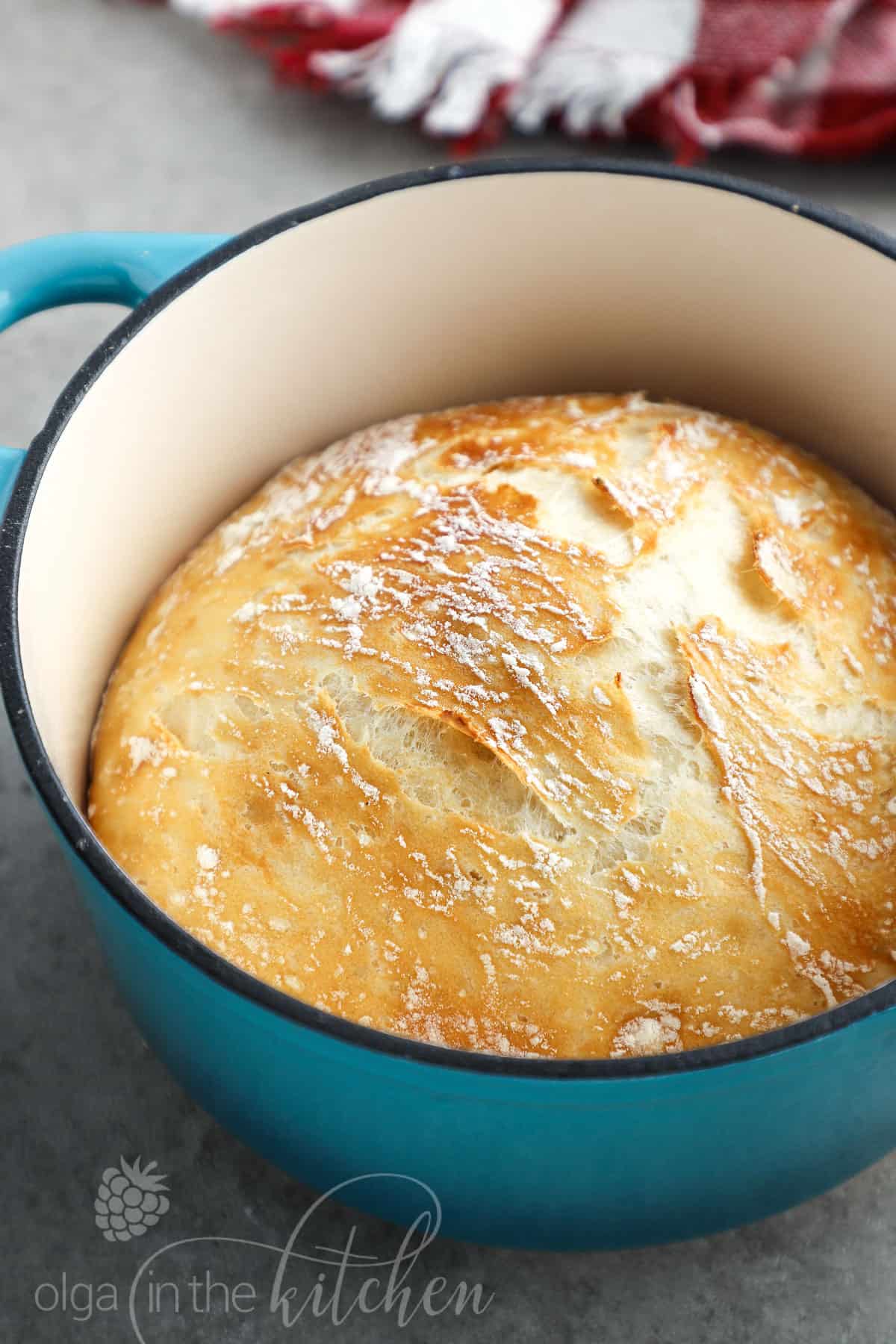
My Bread is Too Dense:
Usually bread is too dense if there is too much flour. Keep in mind that this dough will be pretty sticky, so don’t be tempted to add more flour. Also, humidity and age of the flour could be another factor.
Follow the instructions and avoid overmixing the dough in the beginning or before baking. There is no kneading required that is why this bread is called ‘No-Knead’.
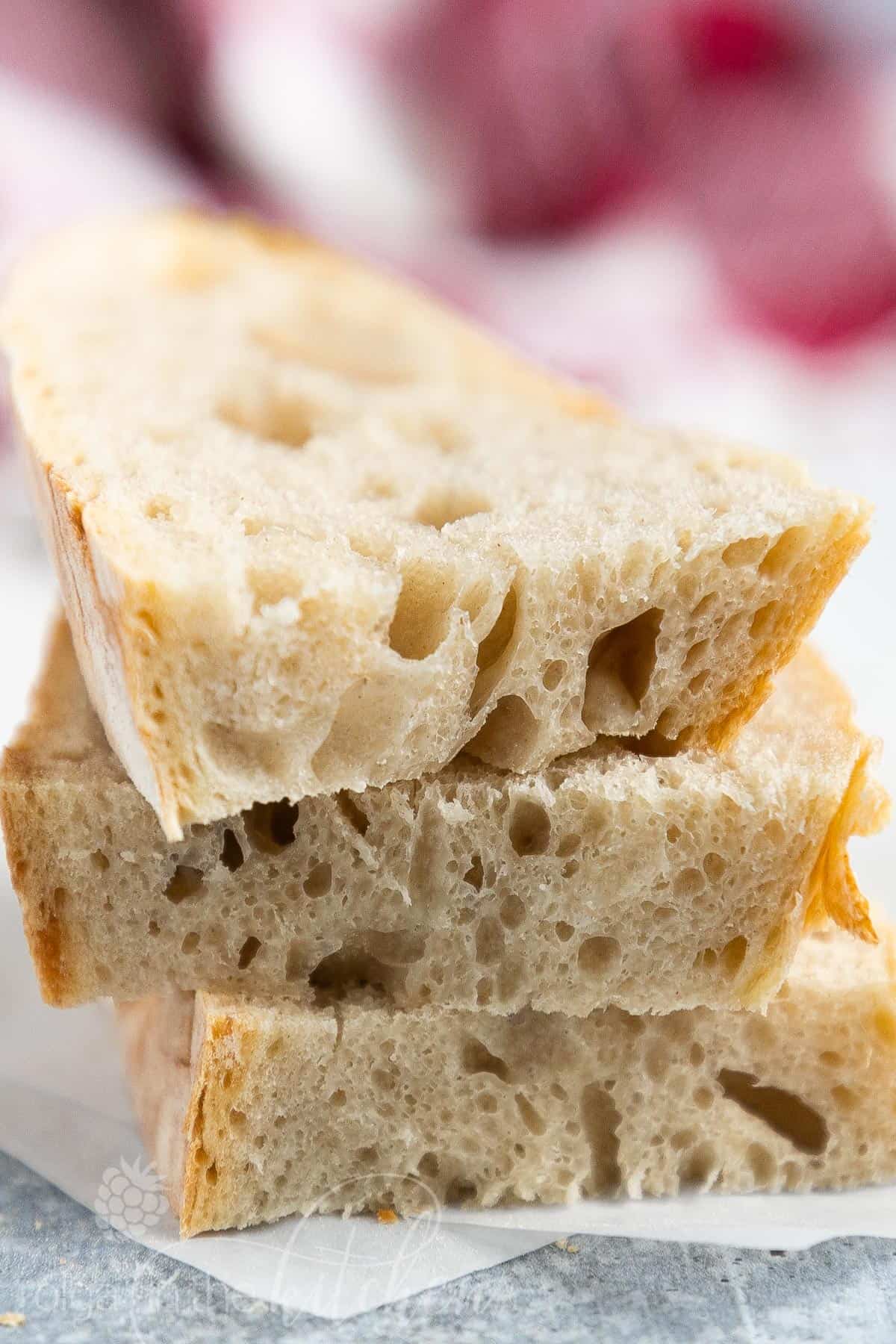
Readers Favorite Bread Recipes:
- White Bread Machine Bread – family staple bread recipe for decades
- Cheese Vatrushka – with the scrumptious cheese filling and fluffy dough
- Ukrainian Pumpkin Bread – this bread is made all-year round (Easter and Christmas are a must!)
- French Bread Buns – these are so easy and go well together with any soup
- Banana Berries Bread – moist banana bread, loaded with fresh berries
- Cherry Pizza Pie – amazing cherry and cheese topping
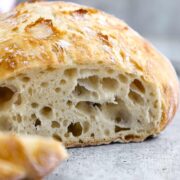
Easy No-Knead Bread
Ingredients
- 3 cups all-purpose flour
- 1 teaspoon fine salt, (for saltier, do 1 1/2 tsp)
- 1/2 teaspoon instant dry yeast
- 1 1/2 cups warm water (100-110°F)
Instructions
- In a glass measuring cup, combine to dissolve 1 1/2 cups warm water and 1/2 tsp instant dry yeast. Let it sit 2-3 mins.
- Into a large mixing bowl, sift 3 cups all-purpose flour and add 1 tsp fine salt. Whisk to combine.
- Pour in the water mixture and use a wooden spoon to stir until all of the flour is incorporated (do not knead). The dough will be very sticky, but do not add additional flour.
- Cover the bowl with a plastic food wrap and let the dough rest on your counter or inside your unheated over for 18 hours to 24 hours.
- Place an empty dutch oven and lid inside the oven and preheat the oven to 450°F. Once preheated, remove dutch oven and place on the stove. Be careful not to touch the dutch oven or lid without oven mitts because it will be very hot.
- Meanwhile, generously dust a cutting board or work surface with flour. Using a rubber spatula, scrape the dough out (which will be very thin and sticky) onto the floured surface. With help of pastry scraper or well-floured hands, shape the dough by folding the dough in half and then fold in half again, pulling the dough together into a loose ball.
- Sprinkle the bottom of the dutch oven with flour or cornmeal and carefully place (or drop) the bread in the center of your hot dutch oven. Cover with lid and bake for 30 minutes at 450°F. Carefully remove hot lid and bake for another 15 minutes to 20 minutes until golden brown.
- Remove the bread from the pot (it should fall out easily) and place directly on wire rack to cool completely until it’s nearly room temperature before slicing it.
Notes
- Use warm water – between 100°F to 110°F. Avoid using hot water or it will deactivate the yeast.
- Substitute for active yeast – instant dry yeast can be replaced for active dry yeast. Use 3/4 teaspoon active dry yeast in this recipe.
- Measure correctly – spoon flour into a measuring cup and level off the top with the back of a knife.
- Rising the dough – draft-free room temperature, unheated oven or turned off microwave. Avoid placing dough into hot oven to rise. Hot temperature will deactivate and ruin the yeast.
- For round, less flat bread – use a 4qt or 5 qt dutch oven so that the bread rises upwards, rather than spreading out over the entire surface of bigger pot.
- Preheat the oven and dutch oven – placing the bread into hot dutch will help form a beautiful crust.
- Flour the dutch oven – to make sure your bread doesn’t stick to the pot, sprinkle flour or cornmeal on the bottom of the preheated pot.
- Cool bread before slicing – always wait for hot bread to cool to room temperature before slicing. Cutting hot bread will release too much steam and the bread will become gummy.

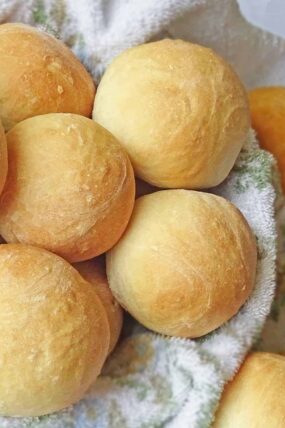
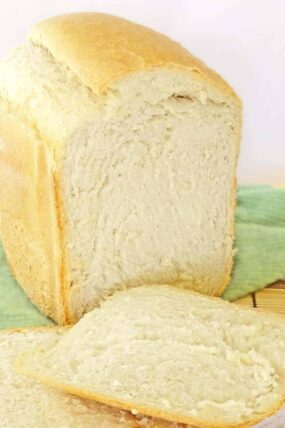
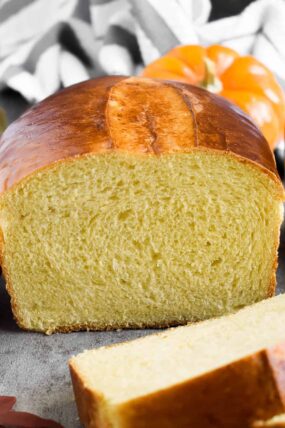
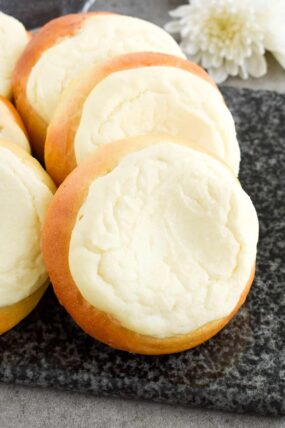
Pam says:
Absolutely the easiest bread recipe I’ve ever made! I made it for the first time yesterday. I added fresh chopped rosemary & thyme. My family was amazed that it was homemade! We ate it all day and then again with soup for dinner. Will probably never use another recipe, and will probably never buy bread again! Thank you so much.
Olga in the Kitchen says:
That’s wonderful, Pam! I’m so happy to hear you and your family enjoyed this recipe!
Aunt Shirl says:
Hi, Olga. I will admit to being a Le Creuset snob. 🙂 My collection is an indulgence I allow myself since retiring. My dutch ovens are all oval for the fit because I do lots of roasts and chickens. Will the bread bake properly in an oval rather than the round style? Thanks. Love your website. Happy New Year!
Olga in the Kitchen says:
I don’t see why not. The bread will just have a different shape (oval) instead of round. You might want to shape it more oval as well so that it has the same amount of dough all around.
Karin says:
I love this recipe – it’s always a success!! I’ve made variations that have worked beautifully as well. I’ve added 2-3 tsp of rubbed sage for a savory loaf; used whole wheat with bread flour; added 3 tsp of cinnamon and ⅓ cup rehydrated raisins for a delicious breakfast bread… so far, everything comes out crusty, tender and delicious! Thanks for a reliably wonderful recipe!!
Olga in the Kitchen says:
Thank you for sharing that with us, Karin! I’m so happy to hear you’re enjoying this recipe!
Ann Colliander says:
This bread is amazing! So easy to prepare and it tastes wonderful!
The only thing I did differently was to add more salt and put a bit of sugar into the yeast water.
I’ve already made 3 loaves this week!
Olga in the Kitchen says:
I’m so happy to hear you enjoyed this recipe, Ann!
Amy says:
Hi, This bread looks great. I just covered the dough and will make it tomorrow. Please let me know on what oven rack the pot should be placed? Thank you for your kind attention to this matter. I will leave a comment after I make it tomorrow too!
Olga in the Kitchen says:
I bake this bread on the center rack.
Georgia J says:
Does the type of Dutch oven matter? I have the black camping style (with a lid), not the enamel coated style, like in your photos.
Thanks!
Olga in the Kitchen says:
I have not tried it myself, but I heard success stories from other readers. As long as it has a lid and can withstand the high oven temperature.
Paula says:
Delicious!!! I’ve made this two times now, and both times, it’s been great. The first time, I made it with no add-ins, and the second time, I made it with garlic and Italian seasoning. Fantastic!
Olga in the Kitchen says:
Thank you for sharing that with us! I’m glad you enjoyed it 🙂
Diana R says:
This is my very favorite bread recipe and it has never failed me. It is so forgiving! I often use 1/2 the flour of another type, like whole wheat, rye or multigrain. Many of your recipes became our favorites. They always turn out from first try and we can tell you put a lot of time and testing before sharing each recipe with the world. Thank you so much!
Olga in the Kitchen says:
I’m so happy to hear that, Diana. I hope that you’ll love every recipe that you will try! Thank you for your kind words and wonderful review. We only share recipes that we truly love and hoping everyone else will love them just as much 🙂
Erin says:
I tried your recipe today and it turned out beautifully, thank you!
Olga in the Kitchen says:
You’re welcome, Erin! I’m so happy you enjoyed it!
Angela says:
Oh my goodness! The bread turned out amazing! Beautiful & delicious 😋
I wish I could load a photo. My husband ate 1/2 the loaf with butter and honey. That would be my only caution. 😂
Thank you…a new go to recipe!
Olga in the Kitchen says:
lol sounds like my husband. We always make 2 at a time because the first loaf tends to disappear in seconds. I’m glad you and your husband enjoyed this recipe! 🙂
Sandie Davis says:
Just curious… you mentioned that you often make 2 loaves at a time… do you mix as a double batch and let rise as one lump in the bowl and then divide before baking? and any changes in baking time, when baking 2 loaves at once? My first loaf is in the oven and it smells HEAVENLY!!!
Olga in the Kitchen says:
I do each batch separately. You can bake each by itself, or sometimes I do 2 at a time. My oven has a fan in it, so it spreads the heat evenly and I don’t adjust baking time. Hope this helps 🙂